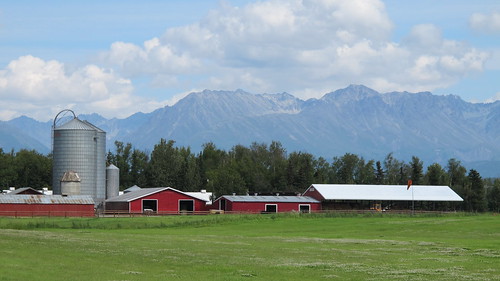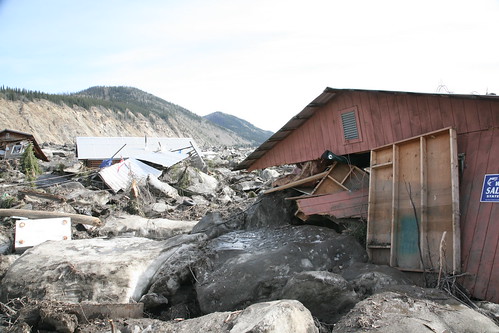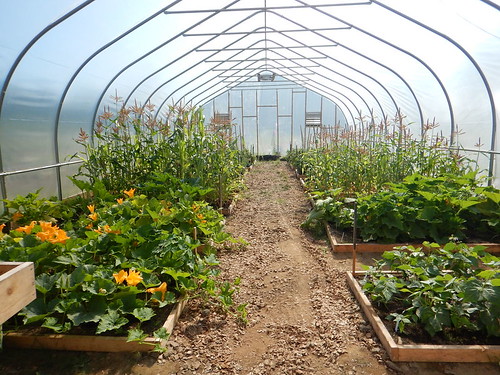
From protecting people and their communities to growing food in high tunnels to restoring streams for salmon to protecting precious soils, the USDA’s Natural Resources Conservation Service (NRCS) has been investing in Alaska’s working lands for 70 years.
The NRCS’s commitment to agriculture in Alaska began on February 19, 1948, when the agency (then the Soil Conservation Service) set up shop in the city of Palmer, one of state’s centers of agriculture. Since that time, the NRCS in Alaska has been steadfast in its mission of helping people help the land.
But fulfilling that mission isn’t easy. Dealing with harsh climate, poor soils, and getting to and working in isolated communities are just some of the challenges that NRCS personnel and the agency’s partners face every day. But through it all, they stay committed to delivering conservation assistance to help make life better for the people of Alaska.
For example, last year, NRCS invested $23 million through its Environmental Quality Incentives Program and Conservation Stewardship Program that helped individuals and entities in Alaska plan and install custom-designed conservation practices that benefit soil, water, air, plants, and animals on privately-owned agricultural and forest lands.
Also in 2017, NRCS and its partners helped land managers implement 2,230 conservation practices through 400 conservation plans – each produced with science-based data to get the highest return on investment and ensure the long-term sustainability of agricultural lands.
Seventy years in the Last Frontier, and we’re just getting started! Find out more about what NRCS has underway in Alaska.
Protecting Communities

Life on Alaskan landscapes can be dangerous. One threat, glacier river erosion, can wash away entire communities. Through the agency’s Emergency Watershed Protection Program, the NRCS helped the community of Eagle purchase an incinerator to safely burn sewage- and fuel-tainted wreckage left behind after flowing automobile-size blocks of ice devastated the town. The incinerator was the right solution as the town had nowhere to dispose of debris. Alaska was the first state within NRCS to use an incinerator for this purpose.
High Tunnel Agriculture

In Alaska, fresh produce can be at a premium because of short growing seasons. The NRCS through its Seasonal High Tunnel Initiative helps growers produce warm-season crops in good soil throughout much of the year. High tunnels also cut the costs of energy needed to grow produce and of transporting produce to market. So just how popular are high tunnels in Alaska? Well, thanks to assistance from the NRCS, The Economist magazine recently called the town of Homer – where there are more than 120 federally-funded high tunnels – the “high tunnel capital of America.”
Supporting Salmon Production
Alaskans are known for raising some of the finest salmon in the world. The state’s salmon fisheries extend from coastal areas and into rivers deep the state’s interior. Through NRCS’s Environmental Quality Incentives Program, the Tyonek Tribal Conservation District near Anchorage, reopened miles of salmon spawning grounds. One culvert replacement project opened up 10 miles of stream, benefitting populations of coho, chinook, and pink salmon. See before- and after-photos of this project.
Tundra and Grazing Management
Tundra is tough stuff, right? Not so. Despite what you learned in grade school geography class, tundra is fragile, easily scarred, and takes time to recover after being damaged. Wildlife, especially ground-nesting birds, suffer when tundra in their habitat is disturbed. Tundra on traditional hunting and gathering grounds is vulnerable to damage caused by ATVs. Special ATV trails built with NRCS assistance give tundra a chance to heal, protect sensitive vegetation, and allow nesting birds and lichen to flourish again.
The NRCS in Alaska takes resource inventories of tundra. These inventories provide reindeer herders data and information they need for good management of rangelands and soils.
Programs and Planning
For more information about NRCS programs, contact local USDA service centers or visit the Alaska NRCS website. Read and download NRCS success stories featuring the Emergency Watershed Protection Program, high tunnels, soils and soil survey, and Farm Bill programs.

